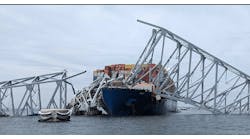Transportation and logistics jobs are so visible they're invisible. So when kids consider employment, rarely do they see themselves as a truck driver or distribution center worker. That's the problem logistics employers face in the coming years. According to a new report from PwC, many transport jobs are considered to be low-paying dead-ends—if they're considered at all.
In the meantime, there are classes of job seekers who are as invisible to the people filling these logistics functions as these functions are to the general population. I'm talking about the aged and disabled. They're invisible because a barrier separates them from those doing the hiring. It's often placed there by the employers, whether they do it consciously or unconsciously. By doing so, these employers do themselves a disservice.
The PwC report cites an employer that is redefining disabled as “differently abled,” and in doing so, not only making these people visible, but making the benefits of employing them compelling. It's Walgreens.
I mentioned them in a blog post earlier this month, focusing on what Randy Lewis, their senior vice president of distribution and logistics, has accomplished. His distribution center in Anderson, S.C. has proven to be 20% more efficient than the chain's older facilities.
The PwC report goes into further detail about how other employers can achieve similar success with this population. The authors ask, “Why shouldn't more applications in transportation and logistics environments also adapt to individual users and thereby make work environments more comfortable for older workers and better suited to the needs of disabled workers?”
In fact, they envision a time when work sites are fitted with flexible, integrated and adaptive tools and devices which are linked to each other. People would configure their individual workplace from off-site via their smartphones.
They also envision the use of exoskeleton-suits that will enable older and less fit workers in a warehouse to do heavy lifting that wouldn't be possible for many today.
But we won't get to that future until employers figure out how to make best use of the differently-abled today. Many just don't know how to go about finding and hiring such people. Curing THAT disability is the business of people like Peter D'Amico and Jim Cawly. D'Amico is a fulfillment center manager for Triangle, Inc.'s Fulfillment Center which trains people with disabilities to receive, assemble, package and distribute products sold by retailers throughout America. These trainees develop marketable skills and get job placements with the help of case managers. In fact, a whole section of D'Amico's work floor is devoted to Walgreens.
“We also have our own line of products like men's tie racks and belt racks,” D'Amico told me. “Our people package them, label them, and they get shipped to TJ Maxx and Marshall's. We also refurbish products for Comcast and bundle up their remote controls.”
Cawly is communications manager for WORK Inc., an organization that serves more than 800 individuals with all types of physical and cognitive challenges in the New England region. WORK Inc. helps place these people in jobs via Federal AbilityOne contracts with government employers.
WORK Inc. works with a Federal agency authorized to administer the AbilityOne Program. This Committee is responsible for determining which products and services are suitable to place on a Procurement List for the Federal government. It also determines the fair market prices for those items. More than 600 non-profit agencies produce products and services using “disabled” workers under the AbilityOne Program.
That brings us back to that word: disabled. It's hard to get away from, but as Jim Cawly says, if these organizations have someone working for them with a “disability,” but they're performing all job functions, then does that person have a disability?
Organizations like Triangle and WORK Inc. get such able disabled people into higher paying jobs and help them succeed. Such success prepares them for work on a broader scale in the private sector, and indeed, takes much of the burden of acclimation off an employer's shoulders.
“Working with an agency like ours they'll have a much higher success rate,” Cawly adds. “People who have been through our program are ready to work. We provide ongoing support for these people, especially the first two or three days.”
So if you'd like to replicate the success and satisfaction people like Walgreens' Randy Lewis have enjoyed, you don't have to go it alone. Just contact a vocational rehabilitation agency like WORK Inc. in your region. The Dept. of Labor also offers “Employer Resources on Recruiting, Retaining, and Advancing Individuals with Disabilities."
As Jim Cawley told me, the biggest cost for businesses is retraining and rehiring people. If you become known as a place that's hospitable to employing people with disabilities you'll get less transient employees. And fewer chances for your logistics operations to be disabled.


